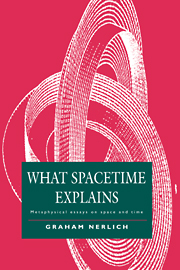Book contents
- Frontmatter
- Contents
- Preface
- Introduction
- Part One Ontology and methodology in relativity
- Part Two Variable curvature and General Relativity
- 6 How Euclidean geometry has misled metaphysics
- 7 What can geometry explain?
- 8 Is Curvature intrinsic to physical space?
- 9 Holes in the hole argument
- Part Three Time and causation
- Bibliography
- Index
6 - How Euclidean geometry has misled metaphysics
Published online by Cambridge University Press: 19 October 2009
- Frontmatter
- Contents
- Preface
- Introduction
- Part One Ontology and methodology in relativity
- Part Two Variable curvature and General Relativity
- 6 How Euclidean geometry has misled metaphysics
- 7 What can geometry explain?
- 8 Is Curvature intrinsic to physical space?
- 9 Holes in the hole argument
- Part Three Time and causation
- Bibliography
- Index
Summary
Introduction
Euclid's geometry is so brilliant that it has always dazzled us. It shone for centuries so brightly as to blind us to any model for an established branch of knowledge but the deductive system based on a few self-evident axioms. Thus it misled metaphysics. But that is not my theme. I want to show how it led Leibniz to some mistaken arguments in the central letters of the Leibniz–Clarke Correspondence. The letters are about quite special issues in the metaphysics of space. But they have dominated philosophy since then as our models of how epistemological arguments should decide metaphysical questions. My theme is to reveal the arguments as mistakes.
Space sets ontology one of its most acute, searching and elegant problems. To change my visual metaphor, the reason why we have not been able to see further into this subject is because a giant has been standing on our shoulders. He is Leibniz. Though the arguments in his letters are fallacious, surely he is a giant. What can make those fallacies clear to us was not available to him nor to his great opponent, Newton. But first, what is the problem space sets for ontology?
On the face of it, space has disconcerting properties. The list below is loosely phrased, and neither exclusive nor exhaustive.
- Type
- Chapter
- Information
- What Spacetime ExplainsMetaphysical Essays on Space and Time, pp. 145 - 168Publisher: Cambridge University PressPrint publication year: 1994



